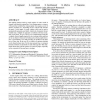Free Online Productivity Tools
i2Speak
i2Symbol
i2OCR
iTex2Img
iWeb2Print
iWeb2Shot
i2Type
iPdf2Split
iPdf2Merge
i2Bopomofo
i2Arabic
i2Style
i2Image
i2PDF
iLatex2Rtf
Sci2ools
WSDM
2009
ACM
2009
ACM
Generating labels from clicks
The ranking function used by search engines to order results is learned from labeled training data. Each training point is a (query, URL) pair that is labeled by a human judge who assigns a score of Perfect, Excellent, etc., depending on how well the URL matches the query. In this paper, we study whether clicks can be used to automatically generate good labels. Intuitively, documents that are clicked (resp., skipped) in aggregate can indicate relevance (resp., lack of relevance). We give a novel way of transforming clicks into weighted, directed graphs inspired by eye-tracking studies and then devise an objective function for finding cuts in these graphs that induce a good labeling. In its full generality, the problem is NP-hard, but we show that, in the case of two labels, an optimum labeling can be found in linear time. For the more general case, we propose heuristic solutions. Experiments on real click logs show that clickbased labels align with the opinion of a panel of judges, e...
| Added | 19 May 2010 |
| Updated | 19 May 2010 |
| Type | Conference |
| Year | 2009 |
| Where | WSDM |
| Authors | Rakesh Agrawal, Alan Halverson, Krishnaram Kenthapadi, Nina Mishra, Panayiotis Tsaparas |
Comments (0)

